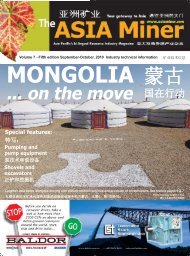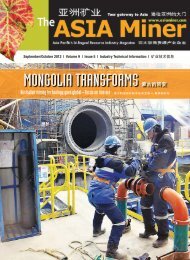Australia's junior explorers - The ASIA Miner
Australia's junior explorers - The ASIA Miner
Australia's junior explorers - The ASIA Miner
Create successful ePaper yourself
Turn your PDF publications into a flip-book with our unique Google optimized e-Paper software.
A significant amount of the consulting work<br />
performed by Metso’s Process Technology<br />
and Innovation group involves Process Integration<br />
and Optimization (PIO) studies, which<br />
includes investigating the effects of drill and<br />
blast design and implementation on downstream<br />
processing. Critical to these studies<br />
is the ability to track specific or e into and<br />
through the plant.<br />
To increase the accuracy of this ore tracking,<br />
Metso Process Technology and Innovation<br />
(PTI) developed a system to track or e<br />
using RFID transponders called SmartT ag.<br />
Since its commercialization in 2007 SmartTag<br />
has been used in the majority of PTI’ s consulting<br />
projects and several permanent systems<br />
have been installed worldwide.<br />
According to PTI, the benefits of using<br />
SmartTag include: linking spatial mine data to<br />
time-based processing data; increased confidence<br />
in ore blending; proactive process<br />
changes for known ore types; and accurate<br />
measurement of r esidence times in stock<br />
piles and bins.<br />
Since 2007, there have been significant advancements<br />
with RFID technology that have<br />
allowed PTI to extend the r each of SmartTag<br />
beyond secondary crushing to tertiary crushing<br />
and even further downstr eam. This has<br />
been achieved by drastically reducing the size<br />
of the SmartTags from a diameter of 60 mm<br />
to 20 mm. <strong>The</strong> new smaller RFID tags have<br />
been successfully used in several studies.<br />
<strong>The</strong> SmartTag System<br />
A SmartTag RFID tag travels thr ough a mine<br />
and mineral processing plant in a series of simple<br />
steps. Initially, the tag and insertion location<br />
is logged using a handheld computer or PDA,<br />
then it is inserted into the ore (e.g., into a blasthole).<br />
<strong>The</strong> tag travels with the ore through digging,<br />
transport and pr ocessing before being<br />
detected at specific locations on conveyor<br />
belts, when the time and specific tag is<br />
recorded. <strong>The</strong> RFID tag data is then loaded<br />
into a database and analyzed as required.<br />
To achieve this, the SmartTag system requires<br />
five main components: <strong>The</strong> first is a<br />
PDA, which allows the initial RFID tag insertion<br />
process to become more efficient and<br />
accurate. Each RFID tag is added to the<br />
database using one of thr ee options—it is<br />
associated with a GPS coor dinate; it is associated<br />
with a predefined point (such as a<br />
blasthole); or it is associated with a new<br />
point, which can be accurately located later.<br />
Grinding Mills<br />
SmartTag<br />
Looking at the Next Generation, and Beyond<br />
Metso reports current developments and the future direction of its RFID-based ore tracking system<br />
<strong>The</strong> SmartTag system utilizes radio frequency identification (RFID) tags and detectors to track ores as they flow from<br />
the blast to the downstream processes and beyond. <strong>The</strong> insertion point of each SmartTag is registered using a PDA.<br />
Currently, the system does not allow for<br />
high-precision GPS but it can locate the<br />
nearest point in a series of predefined points,<br />
such as blastholes, and allow the user to associate<br />
RFID tags with these points.<br />
<strong>The</strong> next component in the system, the<br />
antenna, is located at the conveyor belts.<br />
<strong>The</strong> antenna both induces a charge on the<br />
tag and also receives a transmitted signal<br />
back from the tag. <strong>The</strong> design of the antenna<br />
is decided by two parameters, which<br />
are its size and its r obustness. <strong>The</strong> size of<br />
the antenna dictates the size and the<br />
July/August 2012 | <strong>ASIA</strong> <strong>Miner</strong> | 61

















